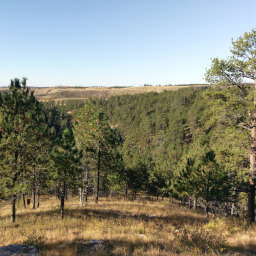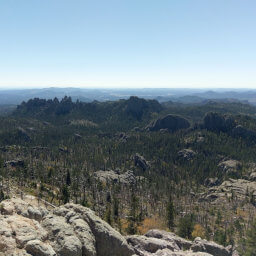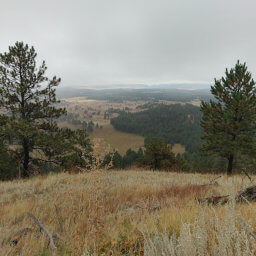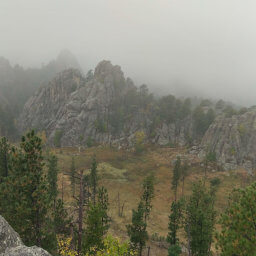| Rating | ★★★★★(5/5) |
| Overall Difficulty | Moderate |
| Navigation Difficulty | Easy |
| Distance | 0.5 miles roundtrip |
| Time | 1.33 hours |
| Terrain | Hilly |
| Best Seasons | All |
| Family Friendly | No |
| Dog Friendly | No |
| Accessible | No |
Highlights
- Wide variety of fascinating cave formations
- Learning about the geologic processes behind the formation of the cave
Hike Summary
After an underwhelming experience and some hot tips from fellow travelers at Wind Cave, I took the short drive from Custer to Jewel Cave National Monument. Now having experienced both of these Black Hills caves, I can say without a doubt that Jewel Cave is better in every way than Wind Cave. Not only is Jewel Cave the third longest cave in the world (and the second longest cave in the U.S., one spot above Wind Cave) with almost 200 miles of mapped passageways, the cave formations are spectacular, something you probably won't say after visiting Wind Cave unless you are a huge fan of boxwork. The tour itself is also more fun, involving more ducking and bending to avoid hitting your head.
At the time of writing, the tour costs $12 for adults 17 and over and $8 for youth between 6 and 16 years old -- more information is available on the park's fee page. Buy your tickets at the booth near the parking lot upon arrival, or reserve online at least 72 hours before your tour date. Click the link to the official site on the bottom of the page for details. Arrive as early in the day as possible if you did not reserve your ticket ahead of time, and be prepared for a long wait before your tour time. Luckily, there are trails you can hike near as well as educational exhibits in the visitor center to help kill the time.
The tour leaves from within the visitor center, where you will take an elevator deep into the cave. The ranger will have you walk across chemically treated mats to prevent the spread of white nose syndrome, a disease destroying bat populations in caves across the country, and then you'll enter the cave in a large room with a metal platform. All along the walls, you can see the crystals that were the inspiration for the name Jewel Cave, as pictured below. After the ranger's short introduction to the cave, the ranger will lead you down stairs into the cave.
One common observation is that the cave walls look like coral reefs or something you'd see on the ocean floor. The picture below shows one example of a coral-like formation. During my tour, there was a funny old woman who noticed the rocks looked like coral, then continued to make nautical references throughout the rest of the tour. "Oooh, those rocks look like a shark's mouth," she would say. The resemblance is real, and if you have a similar person (or imagination) on the tour you will also have "Under the Sea" playing in your head as you "swim" through the cave's rooms and passages. As you go deeper into the cave, the ranger will stop you in various rooms to explain the different cave formations found here, including the stalactites and cave bacon pictured below. You will learn more about the cave's history too, which unlike Wind Cave, there isn't a significant Native American association with Jewel Cave. However, both caves share a similar story of entrepreneurial pioneers who hoped to attract tourists to the caves they discovered. The cave was found in 1900 by the Michaud brothers, Frank and Albert, who described it as a small opening in the ground blowing air. This opening was too small for a human to enter (which is why Native Americans probably didn't visit the cave). Being curious prospectors, they used dynamite to blast an entrance and discovered a cave filled with sparkling "jewels". They attempted to make the cave a tourist attraction, but when they opened for business in the early 1900s travel was difficult and the region was mostly unpopulated. Eventually President Theodore Roosevelt declared the area Jewel Cave National Monument in 1908, and the brothers sold their unsuccessful venture. You'll also learn more about two of the most important people to the cave's history, Herb and Jan Conn, whom many of the passages are named by and for. These two rock climbers were well known for establishing many of the climbing routes in the Black Hills by the time their geologist friend Dwight Deal had invited them to help him explore Jewel Cave. At first they were reluctant to accept, but they were hooked after just one journey. In a 20 year period, they mapped over 60 miles of the cave. In fact, the duo discovered this very Scenic Tour route in 1961 and helped design the lighting system and construct the trail.
A little over halfway through, you'll reach the lowest point of this cave tour, meaning that you will mostly climb stairs for the rest of the journey. Fortunately, you will return to the surface using a lower elevator than the one where you started, saving your legs at least a little bit. At some point near the end you'll encounter the beautiful crystal disc pictured below (I almost hit my head on it), just another example of the wonderful geology buried deep beneath the earth. Near the end of the tour, the ranger will explain different ways you can become involved with the cave volunteering for preservation or exploration work. Despite the vastness of the cave, airflow measurements estimate that only 5% has been discovered! If you fancy yourself a spelunker, try the other tours in this cave, particularly the 4 hour Wild Caving Tour. That tour is not for the faint of heart -- in the visitor center courtyard, you'll see a concrete box representing the smallest space you'll have to crawl through during that tour (it's only 8 inches tall by 24 inches wide), and you must fit to buy your ticket!
After the hour and 20 minutes elapses, the ranger will lead you back up the elevator and into the light once more. Check out the exhibits in the visitor center if you haven't already to learn more about the cave you just experienced. I hope you enjoy your cave tour! Connect with me using the social media links below and share your adventures!
Important Information
No dogs are allowed within the cave. Despite being only a half mile long, the amount of stairs makes this a difficult tour for small children. In addition, note that children may not be carried except for infants and toddlers in front-carriers and that strollers, backpack carriers, and diaper bags are prohibited in the cave. If you do have young children, the Discovery Talk is a ranger recommended alternative. Backpacks, food and drink of any kind (including water bottles!), purses, walking sticks, and hiking poles are all not allowed in the cave and must be safely stowed in your vehicle.
The temperature in the cave is at a constant 49 degrees regardless of the conditions outside, so wear extra clothing. Note that clothing and footwear worn in any other caves are prohibited in order to prevent the spread of white-nose syndrome, a fungus harming bat populations throughout the U.S. While the cave is lit with permanently installed fixtures, bringing your own flashlight or headlamp is recommended so you can better see cave formations -- especially those that are unlit.
Cave tours are available all year, though the frequency diminishes significantly during the off-season. Tour size is limited to 30 people and fills up fast, so it is highly recommended that you arrive as early as possible to purchase tickets for the tour time you want. Ticket reservations are available for this tour only and can be made at most 90 days and at least 72 hours before the tour online -- click the official page link below for more information.
Directions
From Rapid City, take U.S. Highway 16 to U.S. Highway 385 and turn left. After entering Custer, turn right onto U.S. Highway 16. Continue straight out of town, then turn left at the signed turn for Jewel Cave National Monument.
Google Maps Directions
Parking, Fees, and Facilities
Parking is free since cave tours are the park's main source of revenue. There are restrooms, water fountains, a gift shop, and educational exhibits in the visitor center -- note there is no food available here.
Nearby Hikes

Jewel Cave National Monument, South Dakota
★★★☆☆(3/5)

Custer State Park, South Dakota
★★★★★(5/5)

Wind Cave National Park, South Dakota
★★★★☆(4/5)

Black Hills National Forest, South Dakota
★★★☆☆(3/5)




